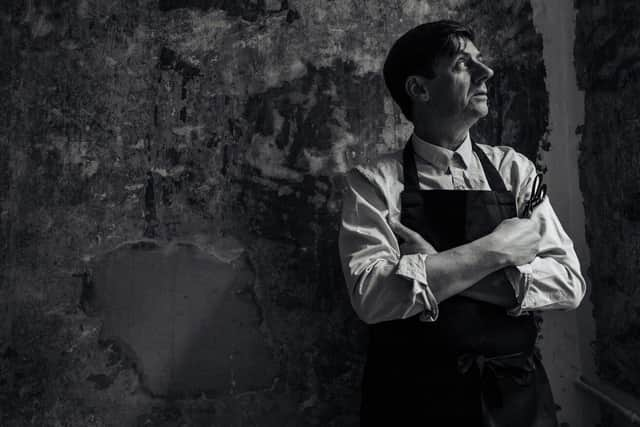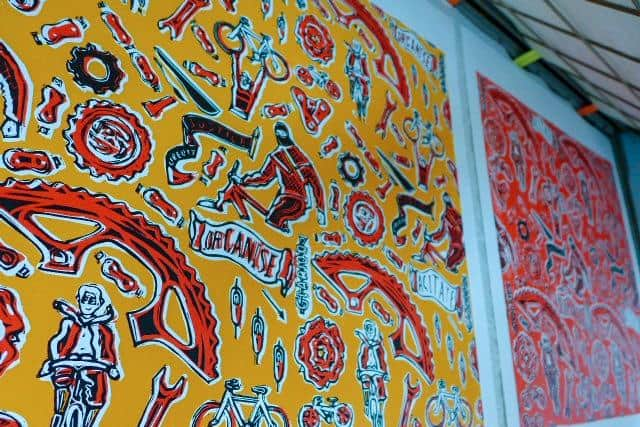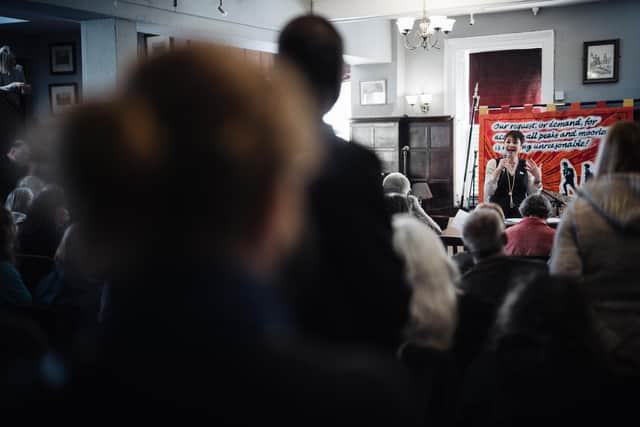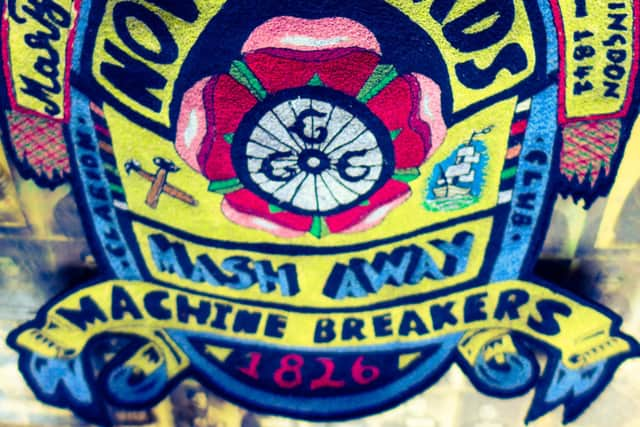“It’s activism, just using cloth!” Lancashire textile artist James Fox on the power of art, working class representation, and working with Maxine Peake
and live on Freeview channel 276
“When I tell people I’m an embroiderer at the pub, you can imagine the looks I get!” says textiles artist James Fox with a laugh. “My background isn’t academic and being a working class artist is frowned upon because art is seen as something which is just a hobby rather than a profession. But art has always interested me as a form of working class expression.
“It’s about sharing ideas,” he adds. “Particularly ideas around politics and working class culture. And Lancashire’s the best place in the world for that combination of working class culture, a rich textiles history, and a strong connection to the trade union movement. That link between history, class, culture, and protest is what led to this exhibition.”
More on that later. First, the man behind the cloth.


Advertisement
Hide AdAdvertisement
Hide Ad“I started out as an engineer,” says James. Born in Glasgow, he found himself out of work during the recession in the ‘80s, embarking on a BTEC and attending college in London. “From the start, I fell in love with machine embroidery,” he adds. “I just really enjoyed getting to grips with it and, because of my engineering background, I could fix the machines, so that helped.
“That’s how it all started - I was using textiles artistically from the start,” he adds. “It was my medium for ideas. The tactile nature of fabrics really appealed to me. Initially, my love was for drawing and painting, but textiles were on another level.”
After working in the fashion industry in the capital for a time, he moved North to work as an engineer once again, but that soon dried up. After training and working as a teacher, James then became a stay-at-home dad, caring for his kids. Over the years, his scope for artistic pursuits had narrowed, but as his children grew up, he was able to explore a bit more freely.
“While I was looking after my kids, art was put on the back-burner for a couple of years because I had to make ends meet but, over the past 10 years, I’ve started again,” James, 57, explains. “And working with the British Textile Biennial and charities like Mid Pennine Arts and Super Slow Way as well as a local homeless centre opened my eyes to the political situation, too.”


Advertisement
Hide AdAdvertisement
Hide AdPolitics, particularly working class politics, define James’ latest exhibition. Titled Freedom of Movement, the show is just the latest manifestation of James’ work, which has been exhibited internationally at events including the 2021 British Textile Biennial, Contextile 2020 in Portugal, the 2016 European Patchwork in Paris, the 2015 Riga International, and the 2012 European Quilt Triennial in Heidelberg.
On show at The Knitting & Stitching Show at Harrogate Convention Centre from 17th-20th November, Freedom of Movement is a celebration of working class culture, trade unionism, and the prominent place textiles have in protest movements. Primarily inspired by trade union banners, which James calls ‘a source of fascination’, it brings textile history to life.
“Bringing the history to the forefront and looking at it in the context of today was the whole idea behind it, because the echoes are clear,” says James, also a part-time PhD researcher at Lancaster University. “Working class voices are still very rarely heard, so it’s all about representation beyond such voices being chastised just for being the voices of the poor.”
Featuring aspects such as a unique tribute to the bicycle, which was totemic as a symbol of female empowerment and in enabling 1880s working class people to escape the grime of factories and embrace the splendour of nearby countryside, the exhibition casts historic concepts under a 21st century lens. Echoes of struggle can be seen today in the climate crisis and working class exploitation through employment practices like zero-hours contracts.


Advertisement
Hide AdAdvertisement
Hide Ad“I’d give everything up if I thought we were going to return to a time when we had better working class representation and strong unions,” says James. “Of course, I do my work because I enjoy art and I love the process, but what I really want to come out of it is a politically active working class: for the people who see it to be moved to do something.
“Lots of people are sidelined and not allowed access to politics through the media and countless other aspects of life, so if I can start a conversation which encourages someone to start down that path to becoming more engaged, then that’s great,” he adds. “That’s why I do what I do: it’s activism, just using cloth!
“Politics dismays me at the moment because it’s like Monty Python in that it’s totally bizarre but exciting at the same time. I just think it’s a frightening time and a potentially horrible time for a lot of people.”
A volunteer with Lancaster and District Homeless Action Service, James has seen how politics can have a sharp impact on people in communities across the North West. Not only was he inspired to create an exhibition depicting service-users’ hands rather than their faces to reflect how homelessness can often render people invisible, but a conversation with a service-user led to something much bigger.


Advertisement
Hide AdAdvertisement
Hide Ad“One day, I was having a conversation with an ex-prisoner about how frustrating his life was because of him being caught in a cycle of crime and prison,” says James. “Maxine Peake [the actor of Shameless, Dinnerladies, Silk, and The Village fame], who I’d worked with before, was really interested and wanted to do something around it, so I made a short film with her. She’s fantastic, so enthusiastic about the work.”
Titled ‘Rights’, the film explores stories including that of Mary Hindle, a textile worker accused of inciting a 1826 riot in which power looms were smashed by weavers furious about losing their jobs. And James has maintained a connection with Maxine, who lent her voice to Freedom of Movement in the form of narration for two soundscapes.
“Maxine is really keen on the right to roam and trespass,” explains James. “In fact, one of her grandparents was involved in the Kinder Scout Trespass [a protest by members of the Young Communist League in the Peak District to highlight that walkers were denied access to areas of open country], which had its 90th anniversary this year.
“I mentioned how I’d been commissioned to do a commemorative banner for the Harrogate exhibition to not only celebrate the anniversary of the trespass, but to protest for the modern right to roam and against the government’s policies stopping predominantly Traveller, Gypsy, and Romani groups from following their culture,” he adds. “Maxine was keen to publicise this as well.
Advertisement
Hide AdAdvertisement
Hide Ad“I created two soundscapes to reflect the two different sides of the piece: the political protest side and the more nuanced ode to the countryside,” says James. “The two soundscapes reflect those two facets: the political and the poetic.”
Balancing those two concepts, the societal power art has and the soft beauty it embodies, is at the very core of James’ work. An engineer at heart, his job is to make all the pieces fit together.